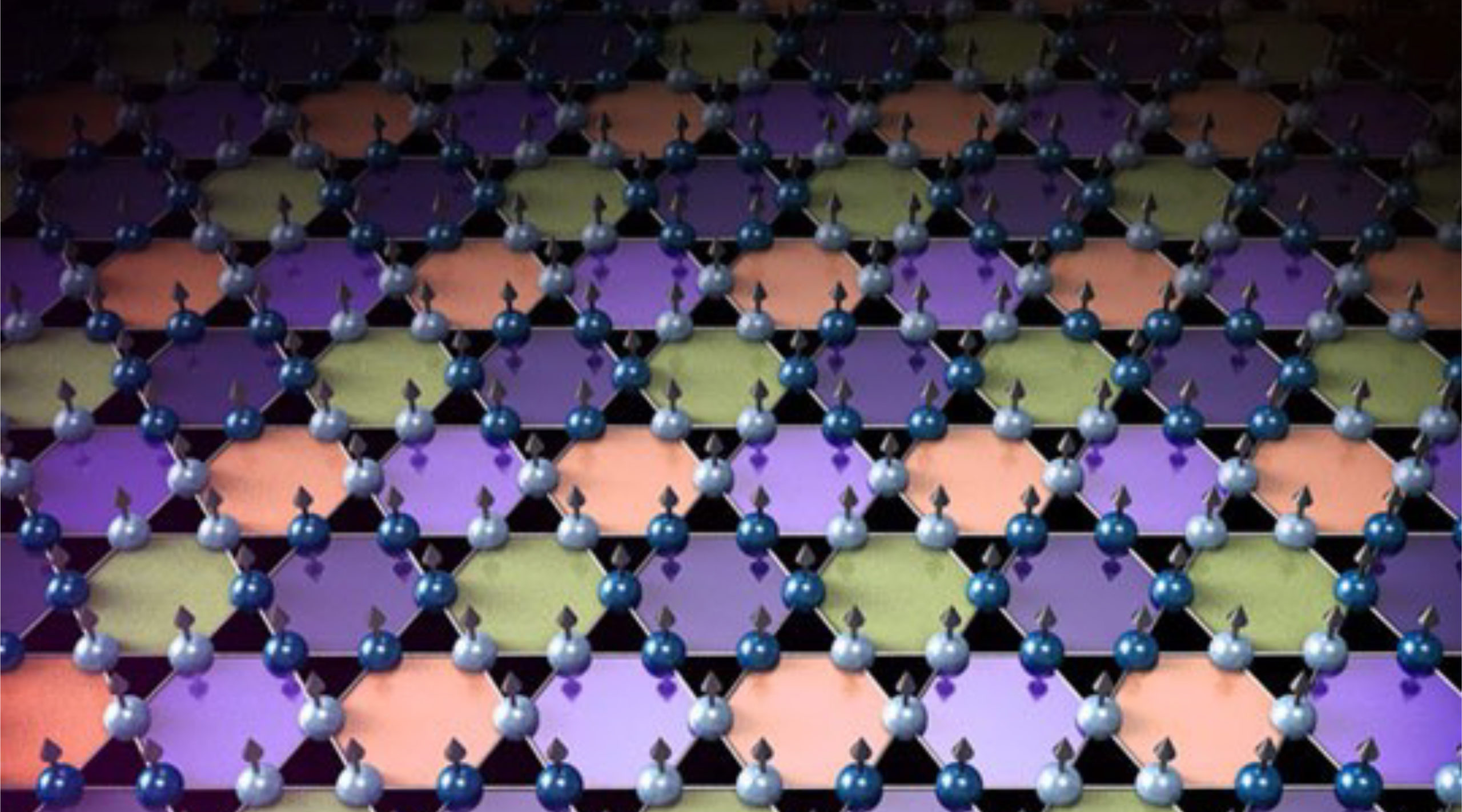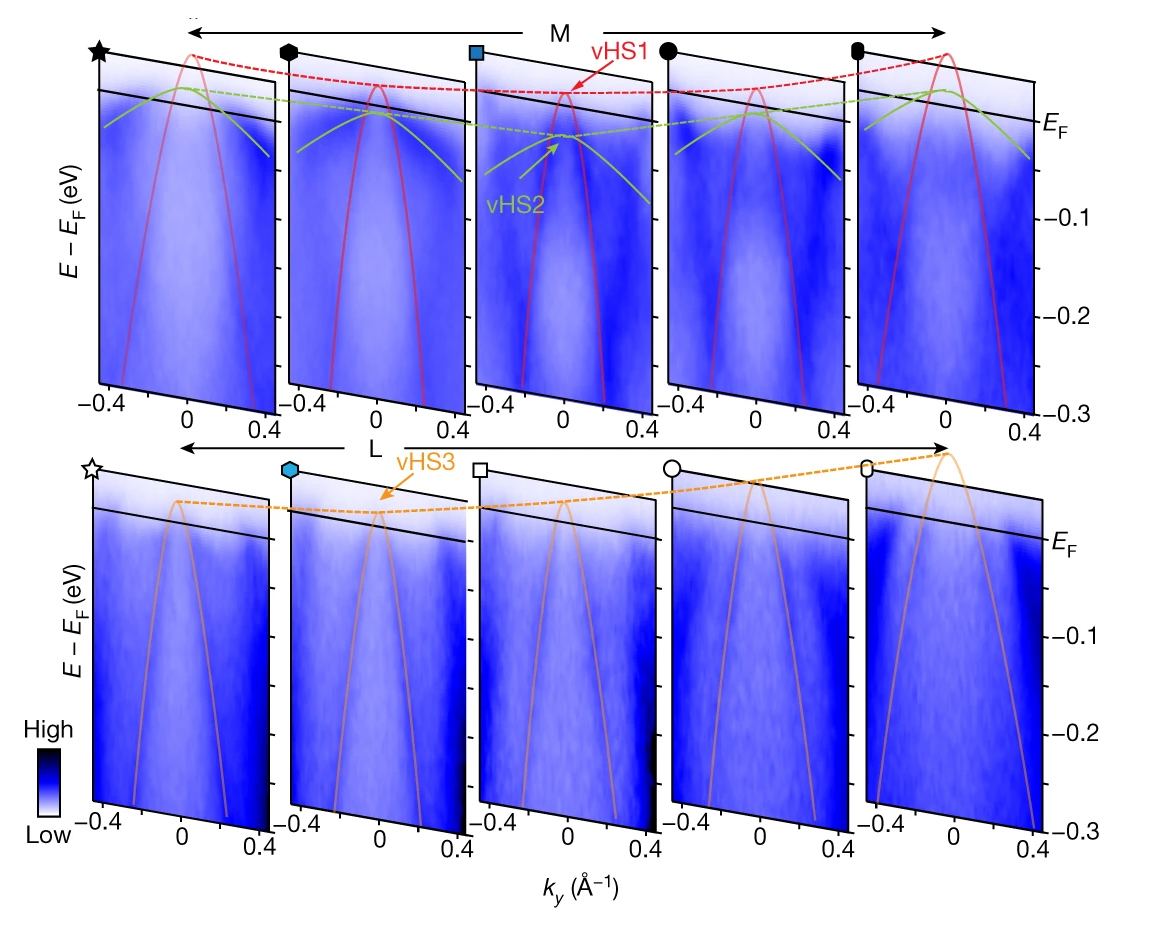| Jan 28, 2023 |
Charge density wave found in magnetic kagome crystal
(Nanowerk News) Researchers discovered a wave-like charge order in a magnetic material with a “kagome” geometric structure and, with key evidence from the Advanced Light Source (ALS), obtained clues to the order’s origins in the material’s electronic structure.
|
|
By helping to connect certain structures with emergent quantum properties, the work brings us a step closer to the goal of creating materials by design.
|
 |
| Artistic rendering of a charge density wave (diagonal lines suggested by colors) in a magnetic iron-germanium (FeGe) crystal. The material is an example of a “kagome” metal with atoms arranged in hexagons (colors) and triangles (black). The arrangement frustrates the movement of electrons (blue and silver spheres), giving rise to collective behavior like the charge density wave. (Image: Jiaxin Yin, Princeton University, and Ming Yi and Pengcheng Dai, Rice University)
|
Novel materials by design
|
|
Quantum materials with exotic properties can lead to transformative technologies such as superconductors and microelectronics. To design such materials, we need to know the mechanisms that give rise to interesting properties. It turns out that, inside a quantum material, properties depend on the collective behavior of electrons, working in an organized way throughout the material.
|
|
In this work (Nature, "Discovery of charge density wave in a kagome lattice antiferromagnet"), researchers discovered such a behavior: a wave-like ordering of electrons called a charge density wave (CDW), in a magnetic material with a kagome lattice structure (characterized by corner-sharing triangles). By probing the behavior of the electrons using angle-resolved photoemission spectroscopy (ARPES), the researchers identified the CDW’s electronic signature – a clue to its origins rooted in kagome geometry.
|
A path to correlated topology
|
|
The study of topological materials (with great potential for spintronic applications) and the study of strongly correlated electrons (which give rise to a rich range of electronic orders) were initially separate efforts that largely progressed in parallel. Scientists are now recognizing that exotic physics can emerge when topology and strong electron correlations are combined in one material system.
|
|
One way to achieve correlated topology is to seek quantum materials with geometrically frustrated electrons. For example, the kagome geometry “frustrates” electrons, preventing them from zooming across the crystal. A number of charge-ordered phases are predicted to appear on a such a lattice. Recently, CDW order has been found in non-magnetic kagome materials of the form AV3Sb5 (AVS), where A = K, Rb, or Cs.
|
CDW in a magnetic kagome material
|
|
Here, researchers studied FeGe, an overlooked kagome material that exhibits robust magnetism. Neutron-scattering studies at Oak Ridge National Laboratory unexpectedly revealed that, like non-magnetic AVS, FeGe also develops a CDW. Most intriguingly, the CDW appeared at lower temperatures than the magnetism (i.e., it developed within the magnetic phase), suggesting a connection between the two phases.
|
|
To explore the origins of the FeGe CDW, the researchers probed the material’s electronic structure using ARPES at Stanford Synchrotron Radiation Laboratory (SSRL) and at ALS Beamline 7.0.2. The small beamspot of Beamline 7.0.2 allowed the researchers to resolve different crystal terminations and obtain intrinsic information about the electronic structure. Also, the beamline’s tunable photon energies allowed the researchers to distinguish surface versus bulk states and map out the complete three-dimensional electronic structure.
|
 |
| ARPES data showing three van Hove singularities (top row: vHS1 and vHS2; bottom row: vHS3). Each panel represents a slice through the three-dimensional data. Dashed and solid lines in each panel delineate the upward and downward curvatures, respectively, of the saddle-shaped vHS dispersions along orthogonal directions in momentum space. (Image: Jiaxin Yin, Princeton University, and Ming Yi and Pengcheng Dai, Rice University)
|
FeGe saddles up
|
|
Earlier studies had revealed that a saddle-shaped feature, called a van Hove singularity (vHS), appears in the AVS electronic structure near the Fermi level. The ARPES data on FeGe also showed this signature, indicating a possible common electronic origin for the two systems. In fact, many aspects of the CDW in FeGe and AVS are similar—suggesting that the CDW may be a universal phenomenon in kagome systems.
|
|
Given that the CDW in FeGe uniquely emerges within a well-formed magnetic order, it offers a new platform for exploring emergent phenomena in strongly correlated topological materials. The researchers are now working to understand how magnetism and the vHS are connected in FeGe, as well as looking into other types of geometrically frustrated lattices where topology appears in the presence of strong electron interactions.
|


